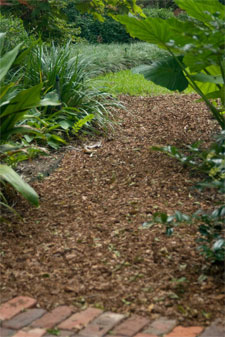From the Sperry Garden – July, 2009

Sometimes you just don’t want more hard-surfaces through your gardens. Perhaps you don’t have enough pavers. (I ran out of these antique street pavers in a seldom-visited area toward the back of our garden.) Sometimes you don’t want anything permanent because you anticipate landscaping changes in the near future. Still, you don’t want to walk through the mud.
Pine bark mulch has come to my rescue for the past 30 years. I buy the smaller screenings (nickel- and dime-sized chunks). While I have to admit to having one favorite brand, it’s not sold everywhere that e-gardens goes, so let me just suggest that you ask the nurseryman to show you examples. They’ll either have samples, or they’ll find broken bags so that you can be sure it’s not full of big chunks and, worse yet, long, stringy fibers.
I contain my garden pathways with green, baked-enamel metal edging. It’s quick and easy to install, and it gives good definition to the walking surface. I slit the bags open and pour them out, usually one bag for about every 4 to 6 feet of pathway. My goal is to have the mulch about an inch deep when I’m finished. It packs flat and makes for easy walking, and it lasts for a couple of years. Successive applications go farther since there’s already a base.
Sure, pine bark mulch floats. I don’t use it on slopes that might wash. It also decays and disappears, but it’s making the garden better for its efforts. All the while, it’s allowing free flow of water and even nutrients into the ground, and it’s also reducing or eliminating invading weeds.
Watch for special sales on your chosen brand of pine bark mulch, then stock up. Not only is it great for the pathways, but it makes a good soil amendment in tandem with compost, Canadian peat moss and rotted manure. And, if all else fails, you can always use it as a mulch – the way it was intended.

